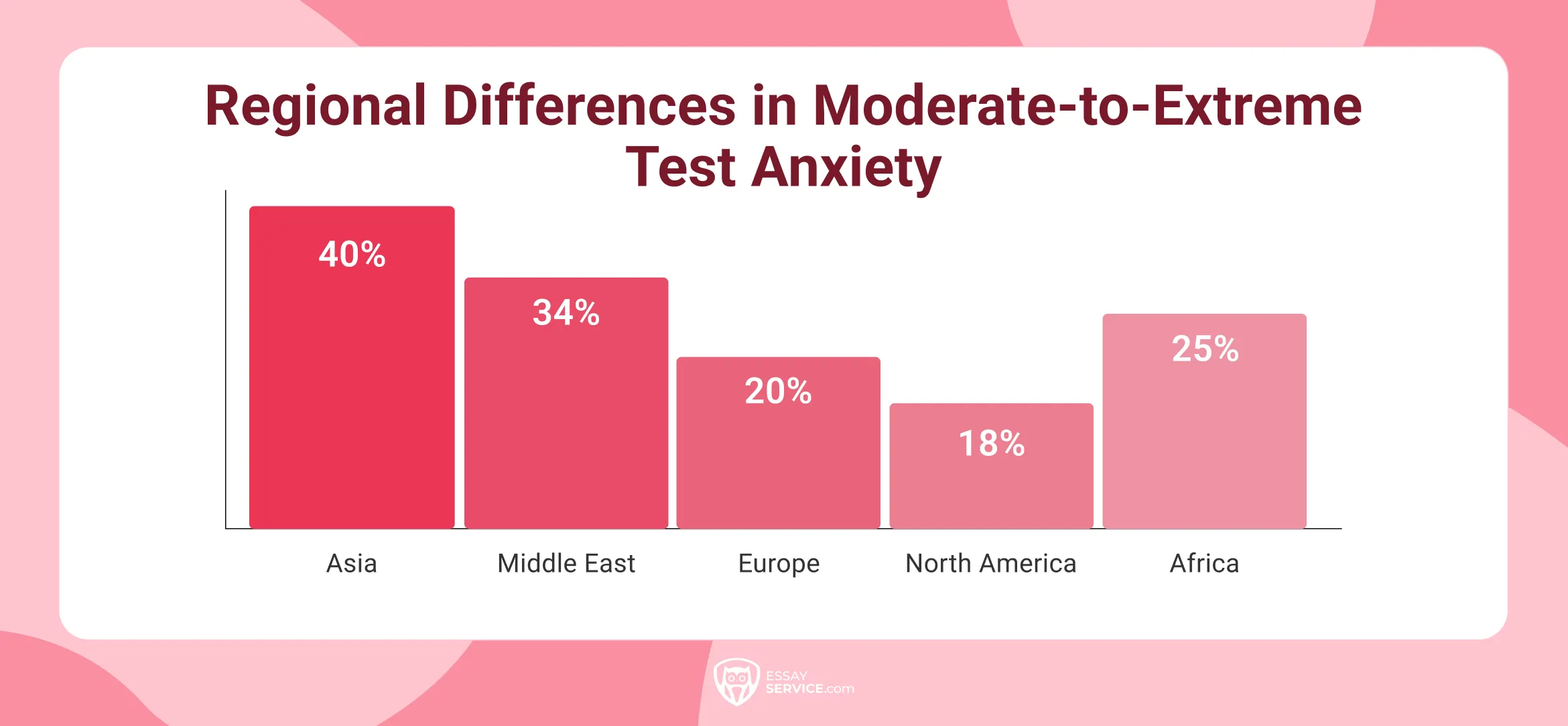Key Takeaways
- About 25-40% of students experience test anxiety.
- Roughly 33% of medical students report anxiety symptoms.
- Nearly 80% of first-year Chinese high-school students experience examination anxiety.
- Around 50% of test-takers fall into the moderately high to extremely high anxiety levels.
- Girls show higher anxiety levels than boys across most studies.
- Severe test anxiety affects about 30-46% of Chinese students in high-stakes exams.
- Highly anxious students score about 12 percentile points lower than low-anxiety peers.
Around the world, millions of learners wrestle with exam anxiety every year. Further research in educational psychology suggests that roughly one‑quarter to two‑fifths of students experience significant academic pressure. In one Chinese cross‑sectional survey about exam anxiety in students, 79.8 % of first‑year high‑schoolers reported having experienced it. These figures hint at just how test anxious students have become. Understanding how this condition develops across different learning contexts remains a focus for future research.
When academic pressure feels overwhelming, EssayService offers professional assistance. Seeking help from our writers can lighten your load so you can focus on reducing anxiety and building confidence.

What Is Exam Anxiety?
Exam anxiety is a state of intense worry and tension that occurs before or during exams, making it difficult to think clearly or perform well. It’s the body’s stress system misfiring, which is the same fight-or-flight response meant for survival. Students caught in that loop often know the material, yet their brains act like they’re being chased, not tested.
Exam anxiety symptoms run deep and appear in different forms. Physiological symptoms include a pounding heartbeat, shaky hands, sweaty palms, and a tight stomach. Some students feel dizzy or nauseous, and others struggle to catch their breath. Emotional reactions include fear, irritability, guilt, and even anger, where the smallest setback can feel catastrophic. Cognitive symptoms complete the picture: racing thoughts, blanking out mid-question, and losing focus halfway through a sentence.
General Exam Anxiety Statistics Insights
Across countries and classrooms, exam anxiety statistics continue to appear prominently in research data and the scale is significant. Research from multiple regions highlights how widespread and persistent the issue is. Here are some key findings:

- Globally, about 30-40% of students experience moderate to high levels of test anxiety during exams.
- Roughly 16-20% of students meet the criteria for high test anxiety, while another 15-20% report mild or moderate symptoms.
- Girls consistently show higher anxiety levels than boys in nearly every age group and education system studied.
- Among medical students, approximately one-third experience clinically significant test anxiety, often tied to academic pressure and long-term evaluations.
- Across universities, test anxiety affects roughly one in four college students, influencing both grades and overall academic performance.
Exam Anxiety Demographics
When you start studying student test anxiety statistics, it becomes clear that it doesn’t affect everyone the same way. The numbers shift depending on where you are in school, what you’re studying, and sometimes, who you are.
Age and Education Level
Anxiety often starts early, sometimes in middle school, but it spikes during the first years of high school. Some studies show that as many as eight in ten high-school freshmen experience serious anxiety before exams.

Roughly one-quarter to two-fifths of university students still wrestle with it. Among medical students, those expected to stay calm under pressure, around a third report ongoing anxiety, and in some first-year cohorts, it can climb past half. Experience helps, but the pressure often intensifies as students advance. Each academic step comes with its own version of the same fear: What if I’m not ready enough?
Gender
There’s another layer to this story, and it’s gender. Across most studies, girls report stronger physical and mental reactions to exams. They’re more nervous and their self-criticism is worse. For boys, anxiety looks different. They might joke about it, avoid study sessions, or shrug it off as stress while still feeling the weight underneath.
As girls grow older, their anxiety responses often intensify. Many describe the body’s response, like the pounding heart and the heat in the face, as worse than the test itself. Boys, on the other hand, tend to treat exams like challenges to conquer, though that confidence sometimes hides its own pressure.

Psychological and Academic Effects of Anxiety Disorders
The brain works in a strange way under pressure: the harder you try to remember the answer, the faster it slips away. Students with intense anxiety often find their scores lagging behind their ability, sometimes by 12 percentile points. That’s not because they didn’t study, but because their minds turned against them at the worst possible time.
While constantly anxious, concentration fractures, motivation flickers, and sleep disappears. Chronic anxiety gradually changes how students approach challenges. They begin to avoid difficult subjects, not out of laziness, but out of fear of failure. As a result, confidence shrinks, and the once-curious mind becomes too cautious, afraid of slipping again.
A quasi-experimental study found that active learning and frequent evaluations significantly lowered test anxiety scores and improved academic performance, showing that structured preparation can both ease anxiety and boost results.
Causes of Exam Anxiety
Test anxiety doesn’t appear overnight. It develops gradually as pressure, expectations, and fear of failure accumulate. Here’s what usually causes it:
- Fear of failure: Many students look at grades as proof of their worth, not just numbers. So every point lost feels personal, and one mistake equals catastrophe.
- Poor preparation and time habits: Anxiety and procrastination go hand in hand. Poor time management creates a cycle of guilt, panic, and endless all-nighters.
- High-stakes pressure: Some education systems treat exams like gateways to a future where one score can decide everything. For students chasing limited spots or scholarships, that tension becomes a constant hum beneath every lesson.
- Social expectations and comparison: Nothing hurts quite like realizing your parents’ praise sounds slightly dimmer. This endless measuring against peers is dangerous for mental health.
- Mental disorders and personality factors: Existing generalized anxiety disorder and depression are potential risk factors. Personality plays its role, too. Students prone to self-criticism or overthinking often dwell on their performance long after the test is over.
How Culture Shapes Text Anxiety
The story of test anxiety looks different depending on where you stand. Culture determines how much pressure a student carries and whether that pressure feels like motivation or confinement.

- Across Asia, test anxiety runs especially high, with 40% of Asian students experiencing moderately high to extreme anxiety.
- In the Middle East, 34% of students report extremely high anxiety. Just like in Asia, here, education is seen as the narrow bridge to success.
- European and North American averages are lower (around 18-20 %). Here, the worry often comes from self-comparison rather than national expectation. Students fear falling behind peers more than failing entirely
- In India, roughly two‑thirds of students report moderate to high test anxiety, showing how fiercely competitive the educational system has become.
In systems with more flexible paths and open conversations about mental health, the pressure softens. The numbers may differ, but the feeling remains universal.
How Students Deal with Exam Anxiety
Some students distract themselves, scroll endlessly, or avoid studying until panic forces them back. These temporary escapes may bring short relief but leave the same anxiety waiting the next day. The good news is that plenty of students find better exam anxiety coping strategies that add up over time.
- Mindfulness and breathing: Simple breathing exercises, moments of meditation, or even holding something steady in your hand, like a pen, a stone, a lucky charm, can work as grounding and slow down your heart rate.
- Breaking tasks into smaller steps: Exams feel enormous until you divide them into parts. Study one topic, take a walk, come back.
- Movement: Physical activity helps release tension and reduce anxiety.
- Positive self-talk and visualization: Replace silent criticism with something steadier, like 'I studied hard.' ‘I know this.’ Picture yourself finishing strong. The brain listens more closely than you think.
How Teachers Help Ease Exam Anxiety
Teachers see anxiety symptoms before anyone else does, and often, they hold more power in reducing exam anxiety than they realize.
Some teachers use what they call the ‘Three Rs’:
- Recognize the anxious thought
- Regroup by breathing or stretching
- Refocus on one small step at a time.
Preparation also plays a key role in managing anxiety. When teachers use regular review sessions, retrieval practice, or online learning tools that let students test themselves without judgment, confidence builds naturally. Students learn to recall information instead of relying on the panic of memorization. And when the serious content is balanced with creative work, such as a game, a debate, or a short project outside the classroom, anxiety starts to loosen its grip.
One of the hardest yet most important things a teacher can do is remind students that grades do not define their identity. The score on a paper doesn’t tell the story of effort, growth, or curiosity, and hearing that, even once, can change how students measure themselves.
Schools can take this further through structured programs. Some interventions teach relaxation, cognitive reframing, and emotional awareness. The most effective ones last several weeks and include check-ins, and behind them, there’s always a teacher or counselor who believes calm minds learn better than fearful ones.
The Bottom Line
Exam anxiety is slowly becoming a persistent issue in modern education. It goes beyond the classrooms and scores, into the everyday lives of students, touching mental health and self-worth.
A little help goes a long way. While juggling essays and endless deadlines, know that EssayService has got your back, always. Our support frees up time for you to study what interests you, rest, and rebuild confidence. And if you’re working with numbers and data yourself and get stuck midway through, simply say ‘do my statistics homework’ and we'll handle the rest
Frequently Asked Questions
How Does Exam Anxiety Affect Students Performance?
Severe exam anxiety disrupts concentration, weakens memory, and lowers test results. Highly anxious students often score around twelve percentile points below their calmer peers and sometimes avoid difficult courses or delay graduation altogether.
What Are the Symptoms of Exam Anxiety in Students?
Symptoms vary widely. Physically, it can cause sweating, nausea, or a racing heart. Mentally, it clouds focus and fuels negative self-talk. Behaviorally, students might skip classes or procrastinate. Emotionally, it often brings frustration, fear, or hopelessness.
When Does Exam Anxiety Usually Start?
It typically begins in late elementary or early middle school, grows stronger during high-stakes high school years, and eases slightly in college. In some schools, more than three-quarters of first-year students report noticeable anxiety before exams.
Are Female Students More Likely to Experience Test Anxiety?
Yes. Girls report more test anxiety, specifically, stronger physical and psychological symptoms, while boys are more likely to mask anxiety with avoidance or humor. The difference shows that pressure takes a different shape in different minds.
How to Overcome Exam Anxiety in Students?
Break studying into smaller, focused sessions. Practice mindfulness or breathing techniques when stress spikes. Prepare early to avoid cramming. Use kind, confident self-talk, and don’t hesitate to reach out to teachers, counselors, or peers for support.

Anna has been helping students become more productive learners for 20+ years now. Her experience, combined with a Master’s degree in psychology, ensures her blog posts contain only valuable insights.
- Domínguez-Lara, S. A., & Campos-Uscanga, Y. (2021). Test anxiety in adolescent students: Different responses according to gender and age. Frontiers in Psychology, 11, 569-579. https://pmc.ncbi.nlm.nih.gov/articles/PMC7770170/
- Adigun, R. A., Olatunji, O. M., Oyeniran, O. I., Adebayo, A. M., & Ayinla, R. (2024). Prevalence of test anxiety and their related factors among medical students. Annals of Medical and Health Sciences Research, 25(1), 12-18. https://journals.lww.com/amhe/fulltext/2024/25010/prevalence_of_test_anxiety_and_their_related.12.aspx
- Ecronicon Psychology and Psychiatry. (2020). Exam anxiety: A review on the causes, effects, and management strategies. Ecronicon Psychology and Psychiatry, 7(2), 258-268. https://ecronicon.net/assets/ecpp/pdf/ECPP-07-00258.pdf
New posts to your inbox
Your submission has been received!



